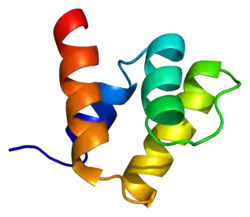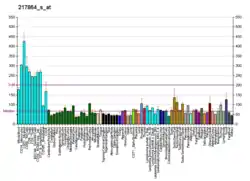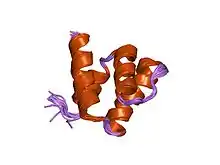PIAS1
E3 SUMO-protein ligase PIAS1 is an enzyme that in humans is encoded by the PIAS1 gene.[5][6][7]
Function
This gene encodes a member of the mammalian PIAS [protein inhibitor of activated STAT-1 (signal transducer and activator of transcription-1)] family. This member contains a putative zinc-binding motif and a highly acidic region. It inhibits STAT1-mediated gene activation and the DNA binding activity, binds to Gu protein/RNA helicase II/DEAD box polypeptide 21, and interacts with androgen receptor (AR). It functions in testis as a nuclear receptor transcriptional coregulator and may have a role in AR initiation and maintenance of spermatogenesis.[7]
Interactions
PIAS1 has been shown to interact with:
References
- GRCh38: Ensembl release 89: ENSG00000033800 - Ensembl, May 2017
- GRCm38: Ensembl release 89: ENSMUSG00000032405 - Ensembl, May 2017
- "Human PubMed Reference:". National Center for Biotechnology Information, U.S. National Library of Medicine.
- "Mouse PubMed Reference:". National Center for Biotechnology Information, U.S. National Library of Medicine.
- Liu B, Liao J, Rao X, Kushner SA, Chung CD, Chang DD, Shuai K (September 1998). "Inhibition of Stat1-mediated gene activation by PIAS1". Proc Natl Acad Sci U S A. 95 (18): 10626–10631. doi:10.1073/pnas.95.18.10626. PMC 27945. PMID 9724754.
- Valdez BC, Henning D, Perlaky L, Busch RK, Busch H (July 1997). "Cloning and characterization of Gu/RH-II binding protein". Biochem Biophys Res Commun. 234 (2): 335–340. doi:10.1006/bbrc.1997.6642. PMID 9177271.
- "Entrez Gene: PIAS1 protein inhibitor of activated STAT, 1".
- Ling Y, Sankpal UT, Robertson AK, McNally JG, Karpova T, Robertson KD. "Modification of de novo DNA methyltransferase 3a (Dnmt3a) by SUMO-1 modulates its interaction with histone deacetylases (HDACs) and its capacity to repress transcription". Nucleic Acids Res. 32 (2): 598–610. doi:10.1093/nar/gkh195. PMC 373322. PMID 14752048.
- Kahyo T, Nishida T, Yasuda H (September 2001). "Involvement of PIAS1 in the sumoylation of tumor suppressor p53". Mol. Cell. 8 (3): 713–8. doi:10.1016/s1097-2765(01)00349-5. PMID 11583632.
- Gallagher WM, Argentini M, Sierra V, Bracco L, Debussche L, Conseiller E (June 1999). "MBP1: a novel mutant p53-specific protein partner with oncogenic properties". Oncogene. 18 (24): 3608–16. doi:10.1038/sj.onc.1202937. PMID 10380882.
- Liao J, Fu Y, Shuai K (May 2000). "Distinct roles of the NH2- and COOH-terminal domains of the protein inhibitor of activated signal transducer and activator of transcription (STAT) 1 (PIAS1) in cytokine-induced PIAS1-Stat1 interaction". Proc. Natl. Acad. Sci. U.S.A. 97 (10): 5267–72. doi:10.1073/pnas.97.10.5267. PMC 25817. PMID 10805787.
- Lee BH, Yoshimatsu K, Maeda A, Ochiai K, Morimatsu M, Araki K, Ogino M, Morikawa S, Arikawa J (December 2003). "Association of the nucleocapsid protein of the Seoul and Hantaan hantaviruses with small ubiquitin-like modifier-1-related molecules". Virus Res. 98 (1): 83–91. doi:10.1016/j.virusres.2003.09.001. PMID 14609633.
- Sapetschnig A, Rischitor G, Braun H, Doll A, Schergaut M, Melchior F, Suske G (October 2002). "Transcription factor Sp3 is silenced through SUMO modification by PIAS1". EMBO J. 21 (19): 5206–15. doi:10.1093/emboj/cdf510. PMC 129032. PMID 12356736.
Further reading
- Tan J, Hall SH, Hamil KG, Grossman G, Petrusz P, Liao J, Shuai K, French FS (2000). "Protein inhibitor of activated STAT-1 (signal transducer and activator of transcription-1) is a nuclear receptor coregulator expressed in human testis". Mol. Endocrinol. 14 (1): 14–26. doi:10.1210/me.14.1.14. PMID 10628744.
- Liao J, Fu Y, Shuai K (2000). "Distinct roles of the NH2- and COOH-terminal domains of the protein inhibitor of activated signal transducer and activator of transcription (STAT) 1 (PIAS1) in cytokine-induced PIAS1-Stat1 interaction". Proc. Natl. Acad. Sci. U.S.A. 97 (10): 5267–5272. doi:10.1073/pnas.97.10.5267. PMC 25817. PMID 10805787.
- Kotaja N, Aittomäki S, Silvennoinen O, Palvimo JJ, Jänne OA (2001). "ARIP3 (androgen receptor-interacting protein 3) and other PIAS (protein inhibitor of activated STAT) proteins differ in their ability to modulate steroid receptor-dependent transcriptional activation". Mol. Endocrinol. 14 (12): 1986–2000. doi:10.1210/mend.14.12.0569. PMID 11117529.
- Gross M, Liu B, Tan J, French FS, Carey M, Shuai K (2001). "Distinct effects of PIAS proteins on androgen-mediated gene activation in prostate cancer cells". Oncogene. 20 (29): 3880–3887. doi:10.1038/sj.onc.1204489. PMID 11439351.
- Liu B, Shuai K (2001). "Induction of apoptosis by protein inhibitor of activated Stat1 through c-Jun NH2-terminal kinase activation". J. Biol. Chem. 276 (39): 36624–36631. doi:10.1074/jbc.M101085200. PMID 11451946.
- Kahyo T, Nishida T, Yasuda H (2001). "Involvement of PIAS1 in the sumoylation of tumor suppressor p53". Mol. Cell. 8 (3): 713–718. doi:10.1016/S1097-2765(01)00349-5. PMID 11583632.
- Weiskirchen R, Moser M, Weiskirchen S, Erdel M, Dahmen S, Buettner R, Gressner AM (2001). "LIM-domain protein cysteine- and glycine-rich protein 2 (CRP2) is a novel marker of hepatic stellate cells and binding partner of the protein inhibitor of activated STAT1". Biochem. J. 359 (Pt 3): 485–96. doi:10.1042/0264-6021:3590485. PMC 1222169. PMID 11672422.
- Megidish T, Xu JH, Xu CW (2002). "Activation of p53 by protein inhibitor of activated Stat1 (PIAS1)". J. Biol. Chem. 277 (10): 8255–8259. doi:10.1074/jbc.C200001200. PMID 11788578.
- Schmidt D, Müller S (2002). "Members of the PIAS family act as SUMO ligases for c-Jun and p53 and repress p53 activity". Proc. Natl. Acad. Sci. U.S.A. 99 (5): 2872–2877. doi:10.1073/pnas.052559499. PMC 122440. PMID 11867732.
- Tan JA, Hall SH, Hamil KG, Grossman G, Petrusz P, French FS (2002). "Protein inhibitors of activated STAT resemble scaffold attachment factors and function as interacting nuclear receptor coregulators". J. Biol. Chem. 277 (19): 16993–17001. doi:10.1074/jbc.M109217200. PMID 11877418.
- Nishida T, Yasuda H (2003). "PIAS1 and PIASxalpha function as SUMO-E3 ligases toward androgen receptor and repress androgen receptor-dependent transcription". J. Biol. Chem. 277 (44): 41311–41317. doi:10.1074/jbc.M206741200. PMID 12177000.
- Rui HL, Fan E, Zhou HM, Xu Z, Zhang Y, Lin SC (2003). "SUMO-1 modification of the C-terminal KVEKVD of Axin is required for JNK activation but has no effect on Wnt signaling". J. Biol. Chem. 277 (45): 42981–42986. doi:10.1074/jbc.M208099200. PMID 12223491.
- Sapetschnig A, Rischitor G, Braun H, Doll A, Schergaut M, Melchior F, Suske G (2002). "Transcription factor Sp3 is silenced through SUMO modification by PIAS1". EMBO J. 21 (19): 5206–5215. doi:10.1093/emboj/cdf510. PMC 129032. PMID 12356736.
- Miyauchi Y, Yogosawa S, Honda R, Nishida T, Yasuda H (2003). "Sumoylation of Mdm2 by protein inhibitor of activated STAT (PIAS) and RanBP2 enzymes". J. Biol. Chem. 277 (51): 50131–50136. doi:10.1074/jbc.M208319200. PMID 12393906.
- Ungureanu D, Vanhatupa S, Kotaja N, Yang J, Aittomaki S, Jänne OA, Palvimo JJ, Silvennoinen O (2004). "PIAS proteins promote SUMO-1 conjugation to STAT1". Blood. 102 (9): 3311–3313. doi:10.1182/blood-2002-12-3816. PMID 12855578.
- Kadaré G, Toutant M, Formstecher E, Corvol JC, Carnaud M, Boutterin MC, Girault JA (2004). "PIAS1-mediated sumoylation of focal adhesion kinase activates its autophosphorylation". J. Biol. Chem. 278 (48): 47434–47440. doi:10.1074/jbc.M308562200. PMID 14500712.
- Tallec LP, Kirsh O, Lecomte MC, Viengchareun S, Zennaro MC, Dejean A, Lombès M (2004). "Protein inhibitor of activated signal transducer and activator of transcription 1 interacts with the N-terminal domain of mineralocorticoid receptor and represses its transcriptional activity: implication of small ubiquitin-related modifier 1 modification". Mol. Endocrinol. 17 (12): 2529–2542. doi:10.1210/me.2003-0299. PMID 14500761.
- Coppola D, Parikh V, Boulware D, Blanck G (2009). "Substantially reduced expression of PIAS1 is associated with colon cancer development". J Cancer Res Clin Oncol. 135 (9): 1287–91. doi:10.1007/s00432-009-0570-z. PMID 19288270.
This article is issued from Wikipedia. The text is licensed under Creative Commons - Attribution - Sharealike. Additional terms may apply for the media files.







